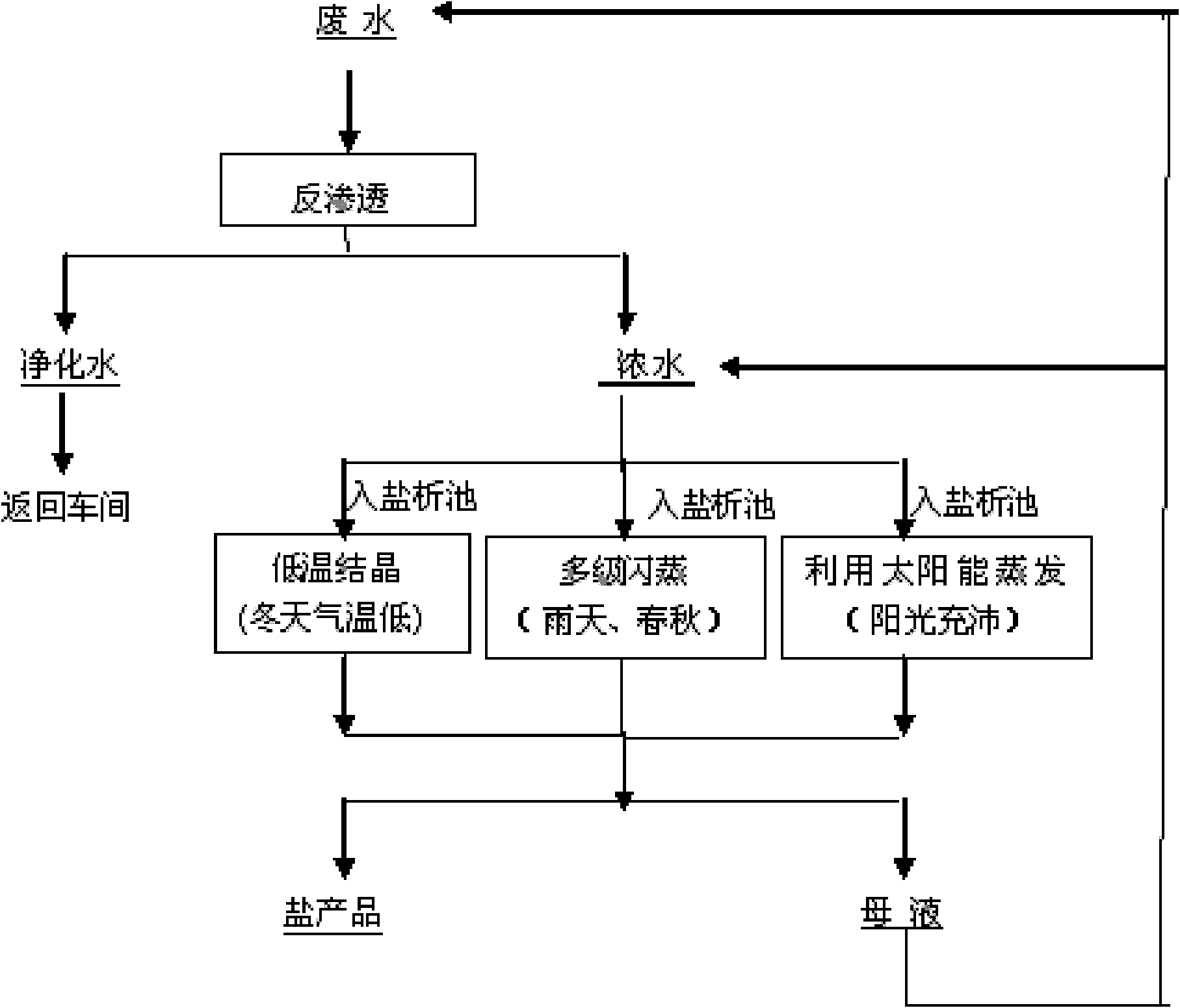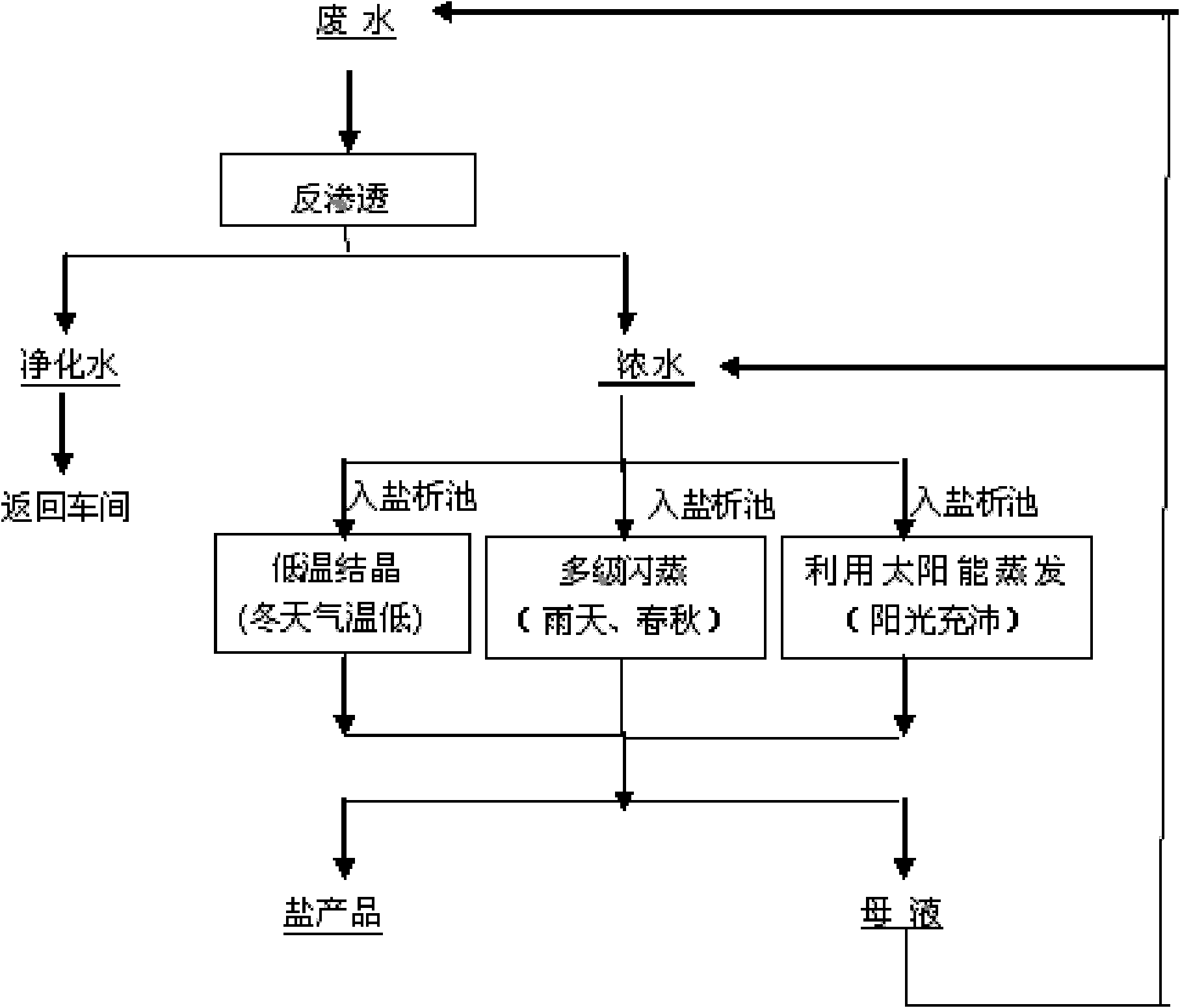A treatment method for high-salt wastewater in waste lithium battery recycling industry
A technology for waste lithium batteries and high-salt wastewater, which is applied in the fields of energy wastewater treatment, water/sewage treatment, heating water/sewage treatment, etc., can solve the problems of high processing cost, difficult recycling, waste of resources, etc., and achieves simple and efficient treatment methods. Economic recovery rate and energy saving effect
- Summary
- Abstract
- Description
- Claims
- Application Information
AI Technical Summary
Problems solved by technology
Method used
Image
Examples
Embodiment 1
[0018] Implementation conditions: summer, high ambient temperature, sufficient solar energy
[0019] Take 100m of high-salt wastewater from the workshop 3 , Na 2 SO 4 The concentration is 94.16g / L, and the pH is 8.1. The above wastewater is treated by reverse osmosis process, which adopts one-stage three-stage reverse osmosis process, and uses low pollution and high desalination composite reverse osmosis membrane to obtain purified water of 51m 3 , Concentrated water 49m 3 ; The purified water is returned to the workshop for reuse, and the Na in the concentrated water 2 SO 4 Concentration is 187.58g / l; Put above-mentioned concentrated water into salting-out pond, utilize solar energy to evaporate naturally to salt analysis, carry out solid-liquid separation to obtain 15.8 tons of Glauber's salt (Na 2 SO 4 10H 2 O) and 5.6m 3 Mother liquor, Na in mother liquor 2 SO 4 The concentration is 397.03g / L, return to concentrated water treatment.
[0020] In this embodiment,...
Embodiment 2
[0022] Implementation conditions: winter, low ambient temperature
[0023] Take 100m of high-salt wastewater from the workshop 3 , Na 2 SO 4 The concentration is 80.16g / L, and the pH is 8.8. The above wastewater was treated by reverse osmosis process to obtain purified water of 51.7m 3 , concentrated water 48.3m 3 ; The purified water is returned to the workshop for reuse, and the Na in the concentrated water 2 SO 4 The concentration is 158.43g / l; the above-mentioned concentrated water is first heated to 70°C by a heat exchanger and then put into the salting out tank, and the air in the tank is turned on to stir, and the salt is analyzed after cooling, and then solid-liquid separation is carried out to obtain 14.15 tons of Glauber's salt and 26m 3 Mother liquor, where Na 2 SO 4 The concentration is 54.08g / l. After heating the mother liquor to 20°C, return to the reverse osmosis process to obtain purified water of 14m 3 12m with concentrated water 3 , Na in concentrat...
Embodiment 3
[0026] Implementation conditions: spring and autumn, rainy season
[0027] Take 100m of high-salt wastewater from the workshop 3 , Na 2 SO 4 The concentration is 95.16g / L, and the pH is 9.3. The above waste water is treated by reverse osmosis process to obtain 50m of purified water 3 50m with concentrated water 3 ; The purified water is returned to the workshop for reuse, and the Na in the concentrated water 2 SO 4 The concentration is 186.58g / l; the above-mentioned concentrated water is treated by multi-stage flash evaporation process, concentrated and evaporated, the slurry is put into the salting out tank, and solid-liquid separation is carried out after cooling to obtain 17.2 tons of Glauber's salt, 9m 3 Mother liquor, where Na 2 SO 4 The concentration was 193.76 g / l. The mother liquor is mixed with concentrated water and returned to the multi-stage flash evaporation process.
[0028] In this embodiment, the waste water recovery rate is 50%, the desalination rate...
PUM
 Login to View More
Login to View More Abstract
Description
Claims
Application Information
 Login to View More
Login to View More - R&D
- Intellectual Property
- Life Sciences
- Materials
- Tech Scout
- Unparalleled Data Quality
- Higher Quality Content
- 60% Fewer Hallucinations
Browse by: Latest US Patents, China's latest patents, Technical Efficacy Thesaurus, Application Domain, Technology Topic, Popular Technical Reports.
© 2025 PatSnap. All rights reserved.Legal|Privacy policy|Modern Slavery Act Transparency Statement|Sitemap|About US| Contact US: help@patsnap.com


